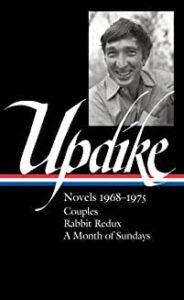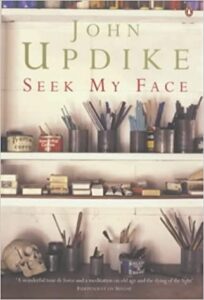Harry “Rabbit” Angstrom and several of John Updike’s other male characters have a stratospheric sex drive and a habit of pursuing sexual gratification so often that their antics have led to charges of misogyny in the #MeToo era. But not according to two women who recently considered several of Updike’s novels.
 In reviewing Updike Novels 1968-1975 (LOA edition, ed. Christopher Carduff), which includes Couples, Rabbit Redux, and A Month of Sundays, Kate Padilla writes on Author Link that “Harry doesn’t appear that bothered” when his wife leaves to move in with her lover in this “dark and disturbing novel, laced with sensual details, common in the other Updike novels in this volume.” But Padilla adds, Updike’s “descriptive, voluminous prose is both dazzling and racy. . . . He skillfully blended extraordinary details in character-driven stories, and the chronology included in this volume offers insights into how he developed his fictional interactions.”
In reviewing Updike Novels 1968-1975 (LOA edition, ed. Christopher Carduff), which includes Couples, Rabbit Redux, and A Month of Sundays, Kate Padilla writes on Author Link that “Harry doesn’t appear that bothered” when his wife leaves to move in with her lover in this “dark and disturbing novel, laced with sensual details, common in the other Updike novels in this volume.” But Padilla adds, Updike’s “descriptive, voluminous prose is both dazzling and racy. . . . He skillfully blended extraordinary details in character-driven stories, and the chronology included in this volume offers insights into how he developed his fictional interactions.”
Meanwhile, in her thoughtful consideration of “the best books about female artists,” Annalena McAfee considers a later Updike novel: “John Updike trained as an artist and turned his observational gifts to fiction, using words with the gorgeous precision of the finest sable  brush. In Seek My Face, his meta-subject is Amerian art since the 1940s, but the focus is a female painter, Hope Chafetz, unfairly but predictably known less for her work than for the men she married (two celebrated artists). There is a roman-à-clef element, summoning echoes of Lee Krasner impatiently batting away questions about Jackson Pollock, as Updike’s elderly painter is interviewed by a thrusting young female art historian. It’s hard to detect in Updike’s extraordinary portrayal of both women the die-hard misogynist depicted by recent critics. He’s as good on female ageing as he is on art, and behind the unsparing observations of humanity, with all its flaws and vulnerabilities, lies a rueful compassion.
brush. In Seek My Face, his meta-subject is Amerian art since the 1940s, but the focus is a female painter, Hope Chafetz, unfairly but predictably known less for her work than for the men she married (two celebrated artists). There is a roman-à-clef element, summoning echoes of Lee Krasner impatiently batting away questions about Jackson Pollock, as Updike’s elderly painter is interviewed by a thrusting young female art historian. It’s hard to detect in Updike’s extraordinary portrayal of both women the die-hard misogynist depicted by recent critics. He’s as good on female ageing as he is on art, and behind the unsparing observations of humanity, with all its flaws and vulnerabilities, lies a rueful compassion.
“‘All a woman does for a man…’ Hope reflects, ‘is secondary, inessential. Art was what these men had love—that is, themselves.'”
